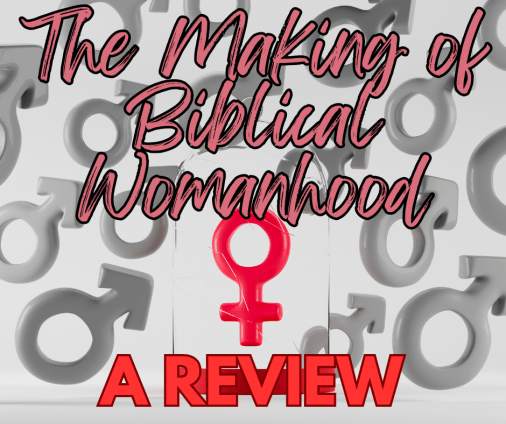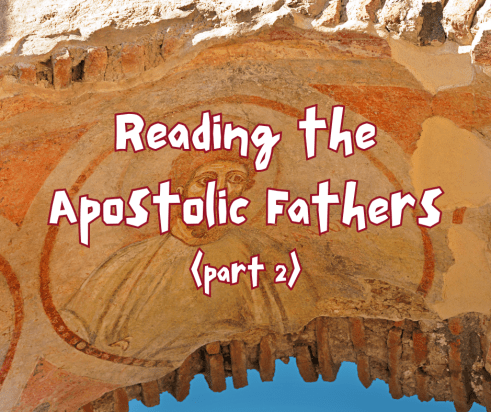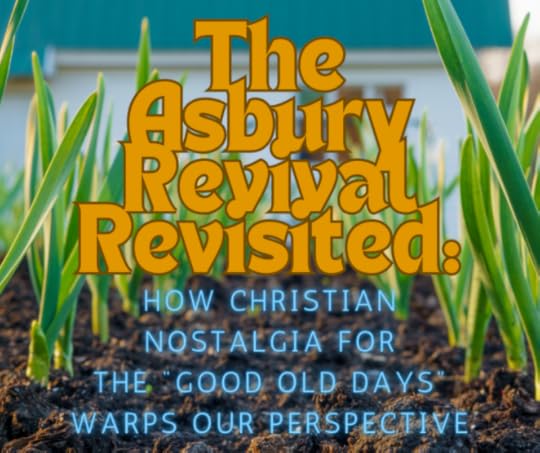Cody Cook's Blog, page 6
May 17, 2024
Problem Passages: Go Buy a Sword (LCI)
MP3/show notes:
https://libertarianchristians.com/episode/ep-370-problem-passages-for-libertarian-christians-go-buy-a-sword/
May 14, 2024
The Making of Biblical Womanhood – A Review

Dr. Beth Allison Barr’s 2021 book The Making of Biblical Womanhood details the complicated history of how women in non-traditional roles like spiritual leadership have been seen in the Western church, raising a challenge against complementarian arguments that the practice of placing women in positions of church authority originates in 20th century feminist philosophy.
She’s largely successful in that. She doesn’t deny patriarchy as the norm in medieval Christianity. Instead, she highlights important exceptions that she thinks push back on two ideas: that women shouldn’t lead in ministry and that the proper place for a woman is in the home.
I found her historical argument to be fairly persuasive. I was surprised, however, by her weaker treatment of the biblical data. The people she’s seeking to persuade are evangelical Christians — a group which, as a rule, is more interested in living their lives by the Bible than by medieval Catholic history. No matter how fascinating her historical research may be, or how compellingly she can show women took part in church leadership at the time, these just aren’t the kinds of arguments that will change an evangelical’s opinion about women in ministry.
She gives surprisingly little consideration to this point. She even claims the reason evangelicals like John Piper take the complementarian view so seriously is because they lack historical insight. It’s as if she thinks John Piper should — or even would — read the Bible through the lens of medieval history! Barr argues further that Christian patriarchy is rooted in the belief in the inerrancy of Scripture. Here she gives up the game completely. If she herself believes that her views are opposed to the Bible, how does she expect to convince her conservative critics to join her cause? Christians who want to be faithful to Scripture will simply turn away: there is nothing for them in her arguments.
She will succeed in persuading the NPR tote-bag-carrying ex-vangelicals. But they already agree with her, so that’s no great feat. Still, they will nod solemnly as she cites disputed data about gender pay gaps and makes the unsupported claim that patriarchy cannot be disentangled from racism. They know full well (she does, too) that patriarchy pre-dates modern racism by millenia. They also know it is still practiced by non-white people and cultures. They will nod solemnly all the same.
It’s not that she ignores the Bible completely. For instance, she closely examines the context of “household code” passages that encourage women to be respectful in church and to their husbands. She argues that the equality that men and women are offered in Christ (see Galatians 3:28) was scandalous in a patriarchal society, so Paul gave guidance to contain that scandal by encouraging orderly and polite behavior. Here she has a stronger case.
In fact, the apostle makes similar arguments to slaves and those who suffered under oppressive governments. Obviously this was a strategy he applied in many circumstances. From this, Barr argues that Paul’s recommendations were culturally situated. Their purpose was to avoid scandalizing the gospel and drawing dangerous negative attention; but they are not universal and not permanent, and they do not undermine the fundamental equality between the sexes.
The most frustrating element of the book is Barr’s own either/or absolutizing which mirrors the mentality of the extreme complementarians she’s critiquing. Examples of this mindset include:
1. Treating complementarianism as synonymous with patriarchy. Many complementarians take much more moderate or even progressive views about women’s roles in society than run-of-the-mill chauvinists do.
2. Asserting that complementarianism and sexual abuse are causally linked. She conveniently ignores evidence to the contrary even when praising the egalitarian wife of an egalitarian pastor who had his own sex abuse scandals which broke two years before this book was published. Since the publication of her book, charges of sexual abuse have also come out against the “hippie” pastor of an egalitarian denomination.
3. Extreme complementarians want women to find fulfillment in domestic life, but Barr seems to center fulfillment through modern work. This is a contemporary white feminist attitude much more deeply rooted in Betty Friedan (whom she mentions approvingly) than in Scripture. She chastises the “cult of domesticity” as a modern phenomenon despite Paul’s own encouragement to young women “to love their husbands and children, to be self-controlled and pure, to be busy at home, to be kind, and to be subject to their husbands, so that no one will malign the word of God” (Titus 2:4-5). While this command is at least partly rooted in concerns for respectability, Paul does seem to see domesticity as a worthy calling for women. Of course, as Barr points out, it is not the only calling for women. Paul himself praises women who reject domestic life to dedicate themselves to God (see 1 Corinthians 7), and seemed to take no issue with women in business (like Lydia) and at least some forms of ministry (Phoebe, Junia, Priscilla, etc.).
4. Barr dishonestly calls the common complementarian view that the Son obeyed the Father from eternity the Arian heresy. Arius’ heresy was not that He believed the Son obeyed the Father, but that the Son was created by the Father and thus not fully divine in the same way that the Father is. Barr and other egalitarians claim that a difference in roles requires a difference in natures, but that is precisely the question under dispute! Complementarians believe that two distinct groups of people can, in some cases at least, be equal in nature but serve different functions.
Reading Barr’s book as someone who is largely egalitarian but also has some complementarian sympathies, I found some of her points to be very persuasive and others not so much.
On the one hand, I support along with her a strong political egalitarianism where women may choose to work, marry, or not marry as they please. I also agree with her that the absolutism of extreme complementarians isn’t faithful to the biblical witness to women who prophesy during communal worship, plant new churches, lead in various capacities, work outside the home, and reject marriage so they may commit fully to serving God. There is indeed a kind of “cult of domesticity” which treats family life as the primary mode of Christian existence, and this cult has only gotten more exaggerated in neo-Christian Nationalist and “trad” sub-cultures. This not only contradicts the words of Jesus and Paul, but their own lives as single persons committed to God! Many women have pursued professional life to the benefit of others and with a sense of personal fulfillment. This is a good thing!
On the other hand, might there also be real differences between men and women? And might those differences show up organically in our social arrangements? Barr agrees with complementarian Albert Mohler that patriarchy is the default for human society. She just argues that this is purely and simply the result of human sin. But maybe patriarchy’s near universality is a form of sinful excess (as Barr states) that’s rooted in something more real (as Mohler claims)–biological differences between men and women. These differences may have stood out more prominently in pre-modern societies where men and women tended to play more distinct roles in the survival of the community; but in modern western society, sex distinctions can seem old-fashioned and largely irrelevant. Childcare options are plentiful, most kinds of work are not gendered, pregnancy has less impact on a woman’s ability to have a career, and birth control/abortion exist to minimize the differences between men and women. But the fact that sex differences aren’t as important in our modern society doesn’t make them non-existent.
In privileging the cult of professionalism over the cult of domesticity, Barr is likely to incur pushback from complementarian men and women who see something sacred in motherhood that they believe is under attack in egalitarianism’s push to get women to “fulfill [their] profession” instead of “[staying] home and [baking] cookies,” as Hillary Clinton once quipped.
Is it telling that some of Barr’s examples of medieval egalitarian heroines are women who abandoned their families to pursue what they perceived as a greater fulfillment in a higher spiritual calling? Isn’t this one of the chief complementarian fears: that families will be destroyed in the wake of mothers trailblazing their own paths outside of the home? Concerns about kids growing up in daycare like some Huxleyan dystopia while their parents pursue other kinds of self-fulfillment aren’t just thinly veiled misogyny or even hysterics–they are rooted in observations about real social changes that are not all necessarily good.
Women who want to reject marriage and motherhood, either because they feel called by God to some other vocation or because they would prefer (for whatever reason, whether pragmatic or even self-indulgent) to join the workforce, should of course be welcome to do so. But they also shouldn’t look down on women who find real value and meaning in God-designed functions like motherhood that are distinctly female. While Barr doesn’t go “full Hillary,” it’s hard not to read in her words a rejection of one kind of cult and a subtle promotion of another.
In short, Barr’s book is not all bad. For instance, the historical data she covers is fascinating and points to a more complicated historical narrative about women’s spirituality and work. The real shortcoming of her work is that she often substitutes her own simplistic view as a replacement for the one offered by extreme complementarians.
May 11, 2024
May 6, 2024
PODCAST: Reading the Apostolic Fathers (part 2)

This episode consists of sections from my short-lived Patreon podcast where I shared my thoughts and insights on the apostolic fathers. Part 2 contains the epistle of Polycarp, the Martyrdom of Polycarp, and the Martyrdom of Perpetua. If you want to read along, all of the writings except the Martyrdom of Perpetua can be found in this book.
Audio:
https://cantus-firmus.com/Audio/20240506-apostolicfatherspt2.mp3
Music:
“Octagon Pt 2” by Polyrhythmics. Licensed under CC BY 3.0
http://www.needledrop.co/wp/artists/polyrhythmics/
“Kitchen Suite” by Spiedkiks.
May 3, 2024
The Asbury Revival Revisited: How Christian Nostalgia for the “Good Old Days” Warps Our Perspective

On February 8, 2023 Asbury University students attended chapel and then didn’t leave. They maintained fellowship and worship in shifts until the 24th, attracting curious outsiders to come and see this alleged work of God. This predictably sparked a debate among Christians about what counts as a real revival.
Many evangelicals flocked to Asbury to be a part of what they saw as a genuine move of God, while many others looked for flaws. The critics compared what took place with their own church’s style of worship and with revivals of previous centuries which have become examples of “good old days” “old time religion.” But are these comparisons legitimate? What is a revival and how do we know when God is truly moving?
DEFINING OUR TERM
Revival is not a biblical word, though our ideas about it are modeled after biblical events when the people of God gathered and the Spirit moved–the day of Pentecost, Solomon’s dedication of the temple, etc.
In popular American usage, a small group of committed, rural Christians preaching and singing in a tent might be called a revival. Some churches will even schedule this spontaneous move of the Spirit and advertise “Revival next week!” on their road sign. Some have hoped for revivals that would spark political change like banning alcohol, abortion, slavery, or electing their favorite politician to the White House. But perhaps the most basic vision of what a revival looks like is when lots of people in a place that was historically seen as majority Christian (to revive means to bring back to life something that has died) become saved or make a serious commitment to Christ.
A “REAL” REVIVAL?
So does what happened at Asbury count as a real revival? The arguments against it are largely factional. Charismatics were skeptical of what happened at Asbury because it was too orderly–the Spirit was “being quenched” by the leaders’ desire to structure the event and not let it turn into a circus. Fundamentalists doubted it because it wasn’t happening at a KJV-only school, they heard that a few of the students identified as gay, or because it was too “emotional.” Some Calvinists were skeptical just because it was happening at an Arminian seminary.
In any alleged movement of God, how can we actually know that it’s truly God and not something humans are manufacturing? This isn’t as easy to answer as we’d like it to be because humans make choices. Everything God does in our lives will be interpreted or responded to by us. When the Spirit moves, we don’t turn into pre-programmed robots who do only what God commands us to.. Instead, God moves in us and through us with our cooperation. We may misunderstand what He wants to do or try to force the move of the Spirit to look like something it isn’t. He may also give us the freedom to understand what’s happening in a way that makes sense for our time and place.
God may be more likely to move when we’re receptive. But then again He could also move even when we aren’t open to it. The latter may look more like revival to us, but the former is also revival. All revivals include both God and humans, so disentangling the two is very difficult to do.
We have similar debates about using music, lights, and emotional appeals to manipulate a spiritual experience. It’s been said that when Jonathan Edwards read his sermon “Sinners in the Hands of an Angry God,” he did so in a monotone to avoid manipulating the crowd (though that didn’t stop him from using dramatic and frightening language in the sermon itself). Nevertheless, his hearers were weeping and fainting in the aisles anyway. Does his lack of emotional cadence prove that it was God and not Edwards who was convicting the hearts of the people?
Another revivalist, Charles Finney, used what had been learned about psychology to make more effective appeals to his audiences. The much revered George Whitefield had been a stage actor before he was a revival preacher, and he used that skillset to become one of the most effective revival preachers of all time. Does their intentional appeal to human nature mean Finney and Whitefield “faked it?”
Not at all. Humans are embodied and not just spiritual beings. God made us that way. There’s nothing wrong with appealing to our embodied experience, so long as the appeal is not manipulative or dishonest. Even so, Asbury did not begin with an appeal to emotion, but with a fairly standard sermon that the preacher himself felt had landed with a thud.
If you’ve romanticized the revivals of centuries past but don’t trust what happened at Asbury, you may be in for a rude awakening about just how complicated these past revivals were and how similar their circumstances were to what took place at Asbury.
THE GREAT AWAKENING VERSUS THE ASBURY OUTPOURING
To keep it simple, let’s focus on one famous past revival–The Great Awakening.
The Great Awakening was a series of revivals originally centered in the northern American colonies in the early 1740s. While they are now seen by many conservatives and fundamentalists as a great movement of God that we should desire today, the Great Awakening was not seen by more conservative Christians of the time as a movement of God or even a positive social force.
Just as with Asbury, there were Christians who were fans of the movement, Christians who saw it as a bad thing, and lots of Christians in the middle who gave the revivals a mixed reception. Enthusiastic supporters were more radical and included elements that were more charismatic and anti-church authority. Detractors supported structured church power and saw the revivals as socially dangerous and disruptive–they didn’t like the radicals’ idea that the Holy Spirit enabled regular Christians (including women, children, Native Americans, and blacks) to be preachers and prophets. It was these white, male college graduates who were the elite. They had been trained to lead churches, not the populist revivalists. As a result, they protected their special authority. Six different ministerial associations joined the faculties of Harvard and Yale in advising ministers to not allow revivalist superstar George Whitefield to ever preach from their pulpits. In some ways the anti revivalists had a point about the disruptiveness of some revivals, such as those marked by uncontrollable laughter and over the top preachers like James Davenport who once took off his pants and threw them into a bonfire.
It’s worth noting that unlike the Great Awakening revivals with these more charismatic elements, Asbury was not marked by this kind of bizarre enthusiasm. One could argue that a conservative who favors the Great Awakening should appreciate the Asbury Outpouring even more.
Also much like Asbury, the Great Awakening was sparked by young people (see Joel 2:28–”Your sons and daughters will prophesy”). The 1734 Northampton revival began when Jonathan Edwards exhorted local youths to be born again and their fervor spread to the whole community. Edwards was a more moderate defender of the Awakening, as well as one of its chief figures, who argued that the emotionalism found at many of the revival meetings was neither an argument for or against their legitimacy. What was really important was whether real spiritual fruit like love, holiness, and generosity was produced in them. The “Old Light” antirevivalists disagreed. They thought conversion should be a sober, thoughtful process instead of an emotional one.
Did the Great Awakening spark an interest in social justice that more progressive minded Christians think should accompany revival? Yes and no. Jonathan Edwards and George Whitefield remained slave-owners as they preached, but the revivals also often had an equalizing effect between colors, economic statuses, and sexes. Some historians have argued that without the Great Awakening’s egalitarian emphasis, the American Revolution might have never taken place.
CONCLUSION
Whenever I hear critics of Asbury comparing it to past revivals, I’ve noticed that the comparisons they’re making are not between two real things, but between a false nostalgia for the past and an imbalanced humbuggery about the present state of the church. They’re telling a story about contemporary decay that doesn’t quite match the realities of history. There’s a good chance that these more conservative critics would not have been supporters of the Great Awakening that they yearn so much for. These kinds of critics need to be both more generous to their opponents and more realistic about how moves of God are filtered through human experience.
Not everything that comes out of Asbury is going to be perfect, but if God uses it to change hearts and move people toward Him, then praise God. The so-called “real revivals” of previous centuries didn’t end slavery or create perfect Christians, but they were still moves of God. Will everyone who participated in the Asbury revival be forever changed by the Holy Spirit? Certainly not. As highlighted above, every revival has attracted charlatans and spiritual tourists. This was the point of Jesus’ parable of the sower: God may sow the good seed of the gospel in our hearts, but it’s our duty to prepare the soil.
Is “Render Unto Caesar” a Problem for Libertarians? (LCI)
I helped kick off a series for the Libertarian Christian Podcast on problem passages for libertarian Christians. This episode is on the famous “render unto Caesar” passage.
Video:
Audio/show notes:
https://libertarianchristians.com/episode/ep-368-problem-passages-for-libertarian-christians-render-unto-caesar/
April 29, 2024
The Limits of Libertarianism (LCI)
Read my latest for the Libertarian Christian Institute:
https://libertarianchristians.com/2024/04/29/the-limits-of-libertarianism/
April 28, 2024
PODCAST: Reading the Apostolic Fathers (part 1)

This episode consists of sections from my short-lived Patreon podcast where I shared my thoughts and insights on the apostolic fathers. Part 1 contains the letters of Ignatius. Stay tuned for part 2 which will include Polycarp, the Didache, and the Martyrdom of Perpetua! If you want to read along, all of the writings except the Martyrdom of Perpetua can be found in this book.
Audio:
https://cantus-firmus.com/Audio/20240429-apostolicfatherspt1.mp3
Music:
“Octagon Pt 2” by Polyrhythmics. Licensed under CC BY 3.0
http://www.needledrop.co/wp/artists/polyrhythmics/
“Kitchen Suite” by Spiedkiks.
April 26, 2024
Race Mythology Redux (LCI)
Check out my new article for The Libertarian Christian Institute:
April 20, 2024
Book Review: Jesus and the Powers by N.T. Wright & Michael F. Bird (LCI)
Read my latest from The Libertarian Christian Institute:
Book Review: Jesus and the Powers, by N.T. Wright & Michael F. Bird




